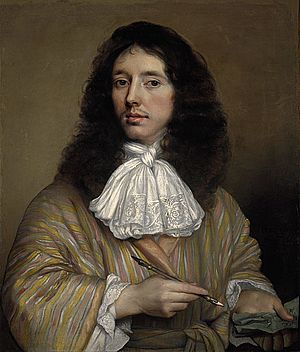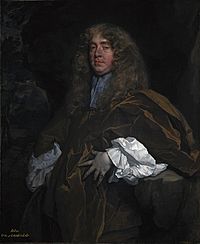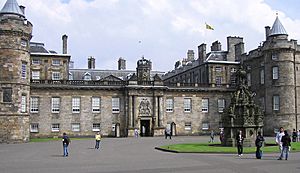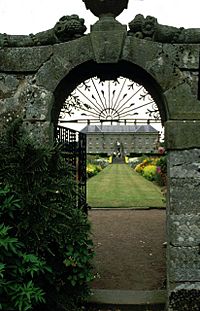William Bruce (architect) facts for kids
Quick facts for kids
Sir William Bruce
|
|
|---|---|

Painting of Bruce by John Michael Wright, c. 1664
|
|
| Born | c. 1630 Blairhall, Fife, Scotland
|
| Died | 1710 (aged c. 79) |
| Occupation | Architect |
| Buildings |
|
Sir William Bruce of Kinross, 1st Baronet (around 1630 – 1710) was a Scottish architect. He is known as the "founder of classical architecture in Scotland." He brought the Palladian style to Scotland. This style was popular in Italy and focused on balance and symmetry. People compare him to famous English architects like Inigo Jones and Christopher Wren.
Bruce worked as a merchant in Rotterdam in the 1650s. He played a key role in bringing King Charles II back to the throne in 1659. He carried secret messages between the king, who was in exile, and General Monck. Because of his loyalty, the king gave him important jobs. One of these was Surveyor General of the King's Works in Scotland. This made him the "king's architect."
His powerful friends included John Maitland, 1st Duke of Lauderdale, who was the most influential person in Scotland at the time. Bruce became a member of Parliament and even served on the Scottish Privy Council for a short time.
Even though he wasn't a trained architect, Bruce became the most important one in Scotland. He worked with skilled builders and taught them about classical design. This helped spread his ideas far beyond his own friends. From the 1660s, Bruce built and updated many country homes. These included Thirlestane Castle for the Duke of Lauderdale and Prestonfield House.
One of his most famous projects was his own home, Kinross, built in the Palladian style. He bought the land near Loch Leven in 1675. As the king's architect, he also rebuilt the Royal Palace of Holyroodhouse in the 1670s. This gave the palace its look that we see today.
After King Charles II died, Bruce lost his political power. Later, when William and Mary became rulers, he was put in prison several times. This was because he was suspected of supporting the Jacobites, who wanted the old royal family back. Despite this, he kept working on architectural projects, often for others who also supported the Jacobites.
Contents
Bruce's Early Life
We don't know much about William Bruce's childhood or his exact birth date. He was likely born around 1630 in Blairhall, Fife. He was the second son of Robert Bruce and Katherine Preston. His family, the Bruces, were loyal to the king and belonged to the Episcopalian church. They were related to King Robert II.
Letters show that William Bruce lived in Rotterdam during the 1650s. He was there with his cousin, Alexander Bruce. As Episcopalians, they were seeking safety from Oliver Cromwell's Puritan government in England. In Rotterdam, they met Sir Robert Moray, a soldier and scientist who was close to King Charles II.
William Bruce was a merchant in the Scottish community in Rotterdam. He traveled a lot, trading wine, coal, and timber. In 1658, he and Alexander traveled to meet Moray. Alexander Bruce and Moray later helped start the Royal Society. It's likely they talked about architecture, especially a new town hall in Maastricht.

In 1659, Bruce became a messenger between General Monck, who was Cromwell's army leader in Scotland, and the exiled King Charles II. Bruce received a special pass from Monck. It seems the messages Bruce carried convinced Monck to march his army to London. This was a very important step in bringing the king back to power.
Bruce's Political Career
After King Charles II returned, William Bruce received important and well-paying jobs. He became Clerk to the Bills in 1660 and Clerk of Supply to the Lords in Council in 1665. Sir Robert Moray, who was now a courtier in London, used Bruce as a trusted messenger. Bruce carried messages between London and the Duke of Lauderdale, who was in charge of Scotland.
Bruce also worked as a tax collector and benefited from the support of powerful people. In 1667, he was put in charge of the Royal Palaces in Scotland. Four years later, in 1671, he became Surveyor General of the King's Works in Scotland. This job came with a good salary and the task of rebuilding Holyroodhouse. Bruce was also part of a group that bought the rights to collect taxes for five years. This meant he was not only the architect of Holyroodhouse but also one of the main people funding the project.
As an important person in the king's government, William Bruce became friends with other loyal supporters. These included powerful people like the Duke of Lauderdale and the Earl of Rothes. In 1667, he started his first building project for Lord Rothes, working on Leslie House. He also worked on several of Lauderdale's properties while also working on Holyroodhouse. In 1668, he was given the title of Baronet of Nova Scotia.
From 1669 to 1674, Bruce was a member of the Scottish Parliament for Fife. Later, from 1681 to 1682, he represented Kinross. His political career reached its highest point from April 1685 to May 1686, when he was a member of the Privy Council of Scotland.
However, in 1674, Bruce got caught up in a fight between his friend Lauderdale and rivals like the Duke of Hamilton. He was accused of sharing information with Hamilton, which made the Duchess of Lauderdale very angry. She tried to get her husband to fire Bruce. Bruce managed to keep his job, but his relationship with Lauderdale was damaged. Lauderdale called him a "bitter factionalist." This led to Bruce eventually losing his job as Surveyor General, with the excuse that Holyroodhouse was finished.
Bruce's jobs had made him a very rich man. This wealth allowed him to buy the Balcaskie estate in 1665 and make the house and gardens bigger. In 1675, he bought the larger estate of Loch Leven, Kinross. This also gave him the hereditary job of sheriffdom of Kinross-shire. In the late 1670s, Bruce started his first projects designing completely new houses.
After James VII became king in 1685, Bruce slowly lost favor. He was not trusted by the new government. After the Revolution of 1688, when William of Orange became king, Bruce disagreed with the new Protestant rulers. He refused to take his seat in Parliament. As a strong Episcopalian, Bruce was seen as a possible Jacobite supporter.
In 1693, he was briefly put in Stirling Castle for not appearing before the Privy Council. He was imprisoned again in Stirling in 1694, and then in Edinburgh Castle from 1696. Bruce was removed from parliament in 1702. His son, John Bruce, took his place. Even with these imprisonments, he continued his architectural work. In fact, the 1690s and 1700s were his busiest years. Bruce was imprisoned in Edinburgh Castle again in 1708 and was released only a short time before he died in early 1710.
He was buried in his family's tomb at Kinross Kirk. The old church ruins are still next to Kinross House. The tomb is still there in the churchyard. It was built around 1675 and was probably designed by William Bruce himself.
Bruce's old records show he bought books on music, painting, and gardening, as well as many books in other languages. This suggests he was a very educated person. He studied gardening a lot and used his knowledge in his own gardens at Kinross.
Bruce's Family Life
Bruce's first wife was Mary Halkett. Their son John inherited his father's title in 1710 but died soon after. John Bruce had no children, so the estate went to his sister, and then to her son, Sir William's grandson, John Bruce Hope.
After his first wife died, Sir William Bruce married Magdalen Scott in 1700. They did not have children. Magdalen lived until 1752 and was known as a Jacobite supporter.
Bruce's Architectural Works
Architectural Inspirations
The Netherlands greatly influenced William Bruce. He was in the Low Countries when Italian classical style was very popular. His work, especially Holyroodhouse, shows similarities to buildings like the Amsterdam City Hall (1648–65) and Maastricht's City Hall (1659–64). Bruce's cousin, Alexander Bruce, had married a Dutch woman. This likely helped connect Bruce to the Dutch builders who worked on some of his projects.
Bruce also knew about northern France. In 1663, he traveled abroad again for Lauderdale, but we don't know where he went. He knew about famous French houses like Vaux-le-Vicomte and the Chateau de Balleroy. These modern French designs had new features not seen in Scotland before. For example, they had two rows of main rooms, back-to-back. These ideas also influenced Bruce's designs.
English architecture also influenced his work. His country houses were similar to the compact Anglo-Dutch style. This style was brought to England by architects like Hugh May and Sir Roger Pratt. Bruce added European details, like the rough stone finish on the front of Mertoun. Roger Pratt's Coleshill House (1660) is often seen as a model for Bruce's Kinross House. Experts believe Bruce used an "international style" that was popular in France, Holland, and England. He was very important in bringing this style to Scotland.
Early Building Projects
Bruce's first jobs involved giving advice to clients and updating existing houses. He didn't design new buildings from scratch at first. He worked on Panmure House and Leslie House. At Panmure, Bruce designed the gates. At Leslie, he took over after the previous master mason died and likely made his own changes. Panmure was torn down in the 1950s, and only a small part of Leslie House remains after a fire. Bruce also advised the Duke of Queensberry on his plans for Drumlanrig Castle.
Bruce also worked on his own property at Balcaskie, Fife, which he bought in 1665. This house still stands today, though it has been changed over time. He made the L-shaped house into a more balanced U-shape. He might have built the curved walls and connecting buildings. These curved walls were a new idea, possibly inspired by the Italian architect Gian Lorenzo Bernini. In the gardens, he created formal flowerbeds and stepped "Italian" terraces. These led the eye towards the Bass Rock, inspired by French baroque gardens. Inside, Bruce created a new room layout. People sought him out for his European-inspired interior designs as much as his exterior plans.
In 1670, the Duke of Lauderdale asked Bruce to update Thirlestane Castle. This was a 16th-century tower house. Bruce, working with the king's master mason Robert Mylne, added new corner buildings and a new entrance. He also redesigned the inside. Lauderdale continued to hire Bruce for his homes near Edinburgh, Brunstane and Lethington (later called Lennoxlove). Bruce also designed new gates for Lauderdale's English property, Ham House, in 1671. While working at Thirlestane, Bruce also designed the nearby Lauder Kirk. This was his only complete church. It is one of the few 17th-century churches in Scotland shaped like a cross. It might have been inspired by a similar church in France.
Holyroodhouse Palace
William Bruce was appointed Surveyor General of the King's Works mainly to rebuild the palace of Holyroodhouse. He also did small repairs to Edinburgh and Stirling Castles. King Charles I had planned to expand Holyroodhouse in the 1630s, but nothing happened. In 1650, a fire destroyed most of the palace. Bruce was hired to design and oversee the rebuilding, with Robert Mylne as the builder. Bruce himself didn't do the technical drawings; Mylne did them based on Bruce's plans.
King Charles II didn't like Bruce's first plans for the inside layout. A better plan was finally approved. Construction started in July 1671, and much of the work was done by 1674. Bruce built a second gothic tower to match the old one built by James V. He also created the courtyard building in a simple classical style. A second phase of work began in 1676. The Duke of Lauderdale ordered Bruce to tear down and rebuild the main west front. By 1679, this resulted in the screen wall with a carved crown, which is the main entrance today.
Also in 1676, Bruce drew up plans to finish Heriot's Hospital in Edinburgh. This building had been started in the 1620s. Bruce's design for the central tower of the south front was completed in 1693.
Country Homes
Bruce's first job to build a completely new house was for Dunkeld House. This came from the Earl of Atholl in 1676. The house had been badly damaged in 1654 during the civil war. Bruce was given the job of building its replacement. (This house was later torn down.) Another early project for a new house was Moncrieffe House (1679), which burned down in 1957.
In 1675, Bruce bought the estate of Loch Leven. This estate included an old manor near Kinross and the ruins of Lochleven Castle, famous as the prison of Mary, Queen of Scots. After fixing up the old manor and starting to design the gardens, Bruce began work on his new home, Kinross House, in 1686. He hired master mason Thomas Bauchop. The Palladian building looks a bit like Roger Pratt's Coleshill House (which was torn down). However, Bruce added features from French designs. These features, which came from classical Italian styles, include the rough stone at the base and the tall Corinthian columns. Bruce's political troubles meant he had money problems, which delayed the house's completion until 1693. Kinross was one of the first Palladian-style country houses in Scotland. It was seen as one of the best buildings in the country.
Even though William Bruce lost political power and was sometimes imprisoned, he kept working. In the 1690s, he finished Hill of Tarvit (1696), Craighall (1697–99), and Craigiehall (1699) near Edinburgh. Craigiehall still stands and is used as the British Army's Scottish headquarters. From 1698, he worked on a new house for Charles Hope, who later became the first Earl of Hopetoun. Hopetoun House, near Edinburgh, was finished in 1702. It is Bruce's grandest country house design. The master mason was again Thomas Bauchop. Most of Bruce's work there is now hidden by changes made in the 18th century by William Adam. Bruce was hired again by Hopetoun in 1708 to build a private section at Abercorn Kirk.
In 1702, the people of Stirling asked Bruce to design the new Stirling Tolbooth. Bruce only provided basic plans, which local masons built between 1703 and 1705. Bruce's last country houses were Harden House (now Mertoun House) and his smallest house, Auchendinny in Midlothian. His final project, around 1710, was Nairne House for the Jacobite Lord Nairne. The house was not finished until two years after Bruce died, so we don't know how much he was involved. Nairne House was torn down in 1760.
Bruce's Legacy
Some people called Bruce "the Kit Wren of North Britain." This means he was like Christopher Wren for Scotland, as he founded classical architecture there. He helped make the "tower house" style less popular. He encouraged building more modern, leisure-focused country houses. Sir John Clerk of Penicuik said Bruce was "the chief introducer of architecture in this country." His work greatly influenced country house design in the 18th century. This influence spread through the masons and drafters he worked with. At Kinross, Bruce carefully lined up the main view with the ruins of Lochleven Castle. This suggests he was interested in the idea of the picturesque, which combines beautiful views with old ruins.









